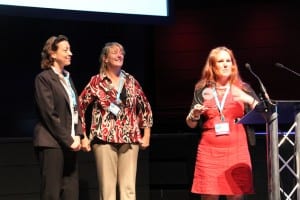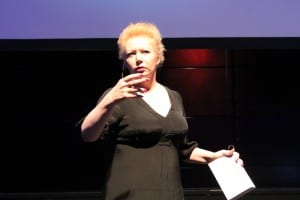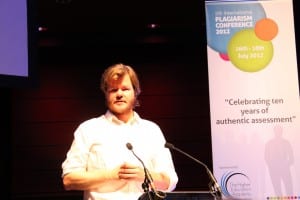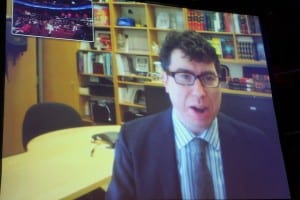The Fifth International Plagiarism Conference: Day Two

I don’t want to spend too much time introducing this day’s events because it’s already going to be the longest post in this site’s history. However, definitely check out my previous day’s coverage if you haven’t.
Not only were there a lot of great talks on day one but many of the themes from the first day carried over into the second so, if you haven’t given that one a look, you likely want to.
Also, if anyone is interested in my notes from the event, I’ve made the Google Doc I used publicly available. However, bear in mind that these were notes taken very hastily as I typed and I can not guarantee sanity, accuracy or grammar. There are definitely mistakes in there and I haven’t had a chance to clean it up.
In short, please go easy on me.
On that note, on to day two!
Welcome
 Presenter: Gill Rowell
Presenter: Gill Rowell
Position and Organization: Academic Advisor PlagiarismAdvice.org
The welcome on the second day was very short and only covered two things.
First, they announced the formation of the IAAIC, the International Association of Integrity Conferences (They are taking suggestions on how to pronounce their acronym if anyone wants to help) and they announced the winner of a poster contest for the new organization.
After that, it was more or less straight into the thick of things.
Keynote 3: Turnitin? Turnitoff: How to Migrate from Software to Wetware
 Presenter: Dr. Tara Brabazon
Presenter: Dr. Tara Brabazon
Organization and Position: Professor of Creative Media and Head of Photography and Creative Media at the University of Bolton
I think it’s safe to say that Dr. Brabazon is a tour de force on stage. When describing her talk many used the word “performance” rather than “keynote” and it fit. She was energetic, passionate and exactly what a tired and weary audience needed at 9 AM.
Her main point was fairly simple: That much of the plagiarism instructors are encountering is systematic of a larger crisis in education, one brought on by an education climate that, according to her, replaces learning with blaming and shaming.
According to Dr. Brabazon, much of the problem comes from instructors and schools that don’t invest in their students and don’t put the time, energy and resources to actually help them grow professionally.
She said that this lack of involvement has rubbed off on the students. One winter break she spent over 160 hours grading assignments, turned in the marks and held onto the actual papers for students to pick up. Of 161 papers, only 4 people came by.
As part of her effort, she no longer posts her slides and, instead, posts a packet of material that includes the base notes (6-8 slides), a short podcast, section overview and key questions. This is to help improve note taking, concentration and attendance among her students.
She also believes in cascading assessment, and feels that poor assessment strategies help encourage plagiarism. She believes in an approach of “Assess and then lift” where she assesses how a student is doing and then lifts them up. She calls herself a “trampoline” in that students should jump off of her and, if they fall, know they won’t hurt themselves.
She structures her assignments to be long term with multiple assessment points. Such as starting with a research proposal, then a key theorist paper, a research diary and then a final research paper. Each step being a phase for assessment and correction.
Keynote 4: Everything is a Remix
 Presenter: Kirby Ferguson
Presenter: Kirby Ferguson
Organization and Position: Filmmaker, Creator of “Everything is a Remix”
To be 100% honest about this talk, I felt it was a missed opportunity. For anyone, such as myself, working in copyright circles Kirby Ferguson is a well-known and respected name, if sometimes controversial. Everything is a remix is widely considered a touchstone of the free culture movement and he is someone who has a lot to say about how our notions of authorship and the law are mixed and how sometimes it can harm culture.
Ferguson started off by showing the first minute of his film and punctuated several other points with clips from it. He talked about how many of the most famous artists we know today got their start by imitating others, including Bob Dylan and Richard Pryor, the latter of which actually started out imitating Bill Cosby.
He talked about that in terms of “Domain Knowledge” meaning that you have to have a certain amount of understanding in your field before you can work in it and you obtain that knowledge by copying. Then you can expand your field by remixing previous works through transformation or combinations, the latter of which is necessary for truly “disruptive” behavior.
The idea of the lone creator, according to Ferguson, is a dying one and that no idea is truly, completely original.
While all of that made for an interesting talk, it was already familiar to anyone who had seen the movie and there wasn’t much application of this to the topic of plagiarism in academia, the focus of the conference.
When Ferguson was asked this point blank as part of the Q&A, he largely sidestepped the question and said that plagiarism was more about citing where you remix from and giving credit to those who came before you.
While it was a great talk, it may not have been the most relevant to the conference.
Workshop 6: A New Approach for Searching Translated Plagiarism
Presenter: Máté Pataki
Organization: Department of Distributed Systems, MTA SZTAKI.
In this break out session, the presenter had a very difficult problem to crack: Translated plagiarism. In his home country of Hungary, students have strong foreign language skills and can trivially find content from other sources, translate them to plagiarize and, as previous tests have shown, escape detection from most plagiarism checkers.
So he and his team built a new tool for checking for translated plagiarism. They couldn’t turn to existing automated solutions because they tend to be either expensive or do not work very well. Instead, they created their own algorithm that was sentence based as words were too short and paragraphs both too hard to define and too long and used a combination of a similarity metric and a “bag of words” to produce results.
And the results were impressive. Using their testbed, the English Wikipedia, they are able to detect translated plagiarism between 40% and 60% of the time. While that may not sound good, this means that if a student plagiarizes more than a couple of sentences this way, they will likely be caught.
However, the system does have limitations, particularly around short phrases and very literal translations. On the up side though, it is easy to add new data sets and new language pairs.
Workshop 7: The Benchmark Plagiarism Tariff: Operational Review and Potential Developments
Presenter: Jon Scott
Organization: Professor University of Leicaster
It’s worth noting two things here: First, though Jon Scott was the presenter, Gill Rowell, Jo Bage and Margaret Green were all involved in the project and deserve credit. Second, the word “tariff” has a different meaning in the UK: “A charge or list of charges either for services or on goods entering a country”
The talk started with a look back to the 2nd International Plagiarism Conference (6 years ago) and the AMBeR survey of penalties for plagiarism. What it found was that there was no consistency between schools or even within school as to what the penalty for plagiarism should be, meaning that two students who commit the same act could get radically different punishments.
The aim of the tariff was to create a consistent approach to plagiarism enforcement. Based on five key factors, the history of the student, the amount/extent of plagiarism, the level of the student, the value of the assignment and any additional characteristics (including evidence of deliberate use), they came up with a point system that would determine what penalties should be handed out.
To test their system, they looked at 155 previous cases of plagiarism and applied the tariff to them. They then looked at the punishment that was handed down vs. what the tariff said and, when there was a difference, tried to explain it.
Most of the cases fell in the middle of the spectrum, what one would expect from a first offense with a modest amount of plagiarism on a basic assignment. Many of the cases did result in different punishments being handed out, but it was typically due to the punishment handed out not being in the tariff, such as mark reduction, capped grades, etc.
Most found that using the tariff was straightforward, even if critical aspects were difficult to evaluate, and the tariff is not geared for collusion cases, which require a different approach, nor does it account for “guilty pleas” and the possible career impact on a student in certain professions.
Workshop 8: Student Perspectives on Plagiarism in Computing
Presenter: Mike Joy
Organization: University of Warwick
To be honest, as a non-programmer a lot of this talk went a bit over my head. Still, I think I can present the core of the talk.
The presenter realized that there was not a good understanding about how much computer science students understood about plagiarism and performed two studies to try and get a better grasp. The first was a literature-based study aimed at looking at prior material and what they gleaned about programming students and plagiarism.
The second was a survey of 770 UK and EU computing students where they were presented 15 scenarios that were unanimously agreed upon by 4 academics to either be plagiarism or not plagiarism. The students were asked to rate their certainty on a scale of 1-5 with 1 being “Definitely Plagiarism’ and 5 being “Definitely not plagiarism”. Each question was given a point for a completely correct answer, half a point for a correct answer without certainty and points were taken away similarly for wrong answers.
What became clear was that programming students fell on a bell curve, averaging a score of 8-9. Clearly, students understood many issues about plagiarism but were less clear on others. In particular were issues about inappropriate collaboration (collusion) as well as programming-specific issues such as using programs to generate code, translating code between languages and self-plagiarism of previous work (only 7% felt non-commented reuse of prior code was plagiarism).
In short, there is a lot of confusion in this field on the acceptable boundaries, which may not be wholly surprising considering that, as an area of academic study, computer science is still fairly new.
Keynote 5: Writing in an Internet Environment
 Presenter: Professor Jonathan Zittrain
Presenter: Professor Jonathan Zittrain
Organization: Harvard University
If you follow copyright issues a great deal, you probably know Jonathan Zittrain’s name. In addition to being a professor at Harvard University, he’s also a board member of the EFF, director of the Berkman Center, worked on Chilling Effects and much, much more. His talk was done via video link but there was nothing artificial about it. He was personable, witty, funny and engaging.
According Zittrain, the main challenge facing students today hasn’t changed with the invention of the computer, the challenge of filling a blank piece of paper. While it may not be a physical sheet, the fears and concerns are much the same though the tools to overcome the challenge are definitely different.
He talked about the “Hamburger Essay”, where three paragraphs of “meat” are sandwiched between an intro and conclusion and,though he talked about essay mills, he referred to them as version 1.0 of plagiarism, asking instead about how we’re going to deal with things such as Amazon Mechanical Turk, which allows people to outsource small projects, such as writing a paragraph, to humans for a small fee.
He also talked about Soylent, a word processor powered by people and how it has a function called “shorten” where you select a section, click a button and humans go to work via the Web to rewrite the passages in a tighter way.
This creates a serious problem as it is harder for students to find “flow” when writing online, largely because of all the tools. However, they do seem to find it better when working in groups, such as with Wikipedia or World of Warcraft.
But despite this, there’s still a strong desire to be attributed for the work you do. He cited Creative Commons as an example and noted that CC got rid of its option to decline attribution because no one used it. According to him, it comes down to reciprocity and a golden rule mentality.
However, the Web is creating another problem. According to him, the number of scholarly papers is doubling approximately every 10 years (which one person during Q&A felt should be dubbed “Zittrain’s Law”) and there are currently over 2,000,000 mathematics papers every year. The number of journals is also rising, but not enough to keep pace and most papers are read by no one.
More and more academics, including himself, are now self-publishing online and trusting the search engines to find the best work. However, that too comes with problems as it puts another machine in charge of finding good scholarly work and those algorithms have been shown they can’t be trusted.
This access creates another issue because works can be removed, as Kindle users found out when Amazon reached into their devices and deleted copies of 1984 they had bought from a publisher that didn’t have the proper rights.
The talk ended with a look at how this would enter the analog world, with cases of reverse attribution (people not wanting to be credited for something they did, such as Star Wars Kid) and the possibility of things such as cameras that automatically pixelate faces.
While the talk may not have been completely relevant, the elements of it that were tied to academia struck home and raised some difficult questions. We’ve just begun to see how technology and social change will impact plagiarism and there’s a lot more to think about.
Workshop 9: Collusion, Collaboration or Help? Issues of Power or Identity in University Group Work
Presenter: Dr. Wendy Sutherland-Smith
Organization: Deputy Vice-Chancellor Academic University of Deacon
The final keynote went a bit over so, unfortunately, this round of workshops got cut a bit short. However, in this talk Dr. Sutherland-Smith had done interviews with students that had been convicted and penalized for collusion and wanted to find out what they had learned.
Unfortunately, the answers were not good. Though prior studies found that academics didn’t see collusions as being as serious as plagiarism, the impact it had on students was stil negative and not particularly helpful.
The 17 students interviewed said that they were still vague on the policy, that there were no clear guidelines, that it was hard to explain what they had done and that the rules varied wildly across disciplines.
One particular case involving a student named Kiara was referenced. Kiara was a post grad that was disciplined for collusion. She said she cried for four weeks straight, felt like a criminal and will now no longer work in a group. She doesn’t care if her peers think her lazy or uncooperative. She still doesn’t understand what happened and refuses to trust anyone on the topic, even her instructors.
Workshop 10: Barrier to Thriving Plagiarism
Presenter: J Kravajar
Organization:
For my final workshop of the conference, we learned about how Slovakia has begun to turn around much of its plagiarism problems on a national level. The country was facing something of a crisis in the area due to low intellectual property rights awareness among students and the lack of measures by colleges to counter ethics violations
The process began in 2006 when a rector’s conference that resulted in measures being proposed for reducing ethical violation at the nation’s schools. In a follow up conference in 2008, the plan was updated to include the use of plagiarism detection software.
The Higher Education Act in the country mandated that all colleges submit theses to a central repository before they are defended. At that time, the thesis undergoes an originality check and the thesis along with its metadata are kept for 70 years.
This kind of mandatory model is unique to the country the Czech Republic is the closest, Poland after that, as both countries have large central repositories but not nearly the level of participation in them.
Two years after the implementation of the system, intellectual property rights awareness went up and students, according to the presenter, are doing better work. However, as he points out, there is room for improvement including reaching out to students earlier on these issues and eliminating gaps in the education process.
Summary
Presenter: Dr. Cath Ellis
Organization: Head of Humanities at the Higher Education Academy
To wrap things up for the conference, Dr. Cath Ellis took to the main stage to encourage the delgates to continue taking plagiarism issues seriously and not sweep these challenges under the carpet. She also reminded everyone of the seriousness of the consequences that come with plagiarism, along with some of the recent cases in Germany, Romania and elsewhere.
She said that higher education had a responsibility to deal with these issues through vigilance, battling complacency, ending lazy thinking, the use of good tools and by crafting good policy.
Wrap Up
All in all, it was a busy but exciting day, it was a shorter day than the first (from a time standpoint at least) but it had more keynotes and some great workshops.
I have made many notes in my admin for this blog for topics I want to cover based upon the various talks and I will be very busy with the ideas and concepts that this day gave me.
Though the conference is over I’m planning two more articles on it directly. One will be Crystal’s notes from the workshops she attended (and I couldn’t) and the other will be more of a broad wrap up and some thoughts I have after I’ve had time to digest and reflect on everything.
However, those two may be a ways off as I’ll be in the UK for a bit longer after the conference. I will touch base with you guys after I return!
Want to Reuse or Republish this Content?
If you want to feature this article in your site, classroom or elsewhere, just let us know! We usually grant permission within 24 hours.
